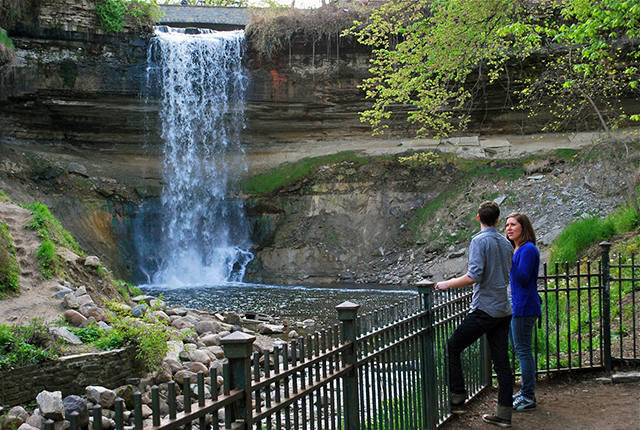Two studies published this week offer yet more support to the growing body of research that suggests living near urban parks or other green spaces offers significant mental health benefits.
In one study, Danish researchers report that children who grow up in greener surroundings are less likely to develop a mental disorder later in life.
In the other study, American researchers suggest that spending just 20 minutes or so in an urban park enhances people’s sense of happiness — whether or not they are exercising while in the park.
Green space in childhood
For the Danish study, which was published in the Proceedings of the National Association of Sciences (PNAS), researchers analyzed data on almost 1 million Danes born between 1985 and 2003. The data came from the Danish Civil Registration System, which includes, among other information, each person’s place of birth and change of residency. The registry also contains health information.
The researchers then used satellite data to map the vegetation density (green space) around the homes where each person lived from birth to age 10.
When they compared the satellite imagery to the people’s health records, they found that growing up near green space was linked with a lower relative risk of developing different psychiatric disorders, including depression, mood disorders, eating disorders, substance abuse and alcoholism.
The drop in risk ranged from 15 percent to 55 percent, depending on the specific disorder.
That association remained even after adjusting for urbanization, socioeconomic factors, parental history of mental illness and parental age, the study authors point out.
There were exceptions, however. Growing up had no effect on the risk of developing an intellectual disability or schizophrenia.
Still, the findings affirm, say the study’s authors, “that integrating natural environments into urban planning is a promising approach to improve mental health and reduce the rising global burden of psychiatric disorders.’
Green space in adulthood
For the second study, which was published in the International Journal of Environmental Health Research, researchers at the University of Alabama surveyed almost 100 adults before and after they entered one of the three urban parks in a suburb (Mountain Brook) of Birmingham, Alabama.
Based on the survey’s answers, the researchers gave each park visitor before-and-after scores for “subjective well being” and “satisfaction with life.”
Less than half (45 percent) of the participants stayed in the park more than 30 minutes, and only 30 percent engaged in physical activity that was at least of moderate intensity.
The data collected by the researchers revealed that people generally left the park in a better mood than when they entered it — even when they didn’t purposely use the park to exercise.
“Overall, we found park visitors reported an improvement in emotional wellbeing after the park visit,” said Hon Yuen, one of the study’s authors and a professor of occupational therapy at the University of Alabama, in a released statement. “However, we did not find levels of physical activity are related to improved emotional wellbeing. Instead, we found time spent in the park is related to improved emotional wellbeing.”
That finding actually surprised Yuen and his colleagues, who were expecting the mood-enhancing benefits of being in the park to be closely tied with physical activity.
The findings therefore suggest, say the researchers, that visiting urban parks can offer everyone — including individuals who cannot be physically active due to age or disability — important health benefits.
Not isolated studies
Both studies come with plenty of caveats. The U.S. study is quite small, for example, and took place in only one urban setting. And the Danish study, although quite large, was observational. That means it can’t prove a direct cause-and-effect relationship between growing up in a neighborhood with lots of green space and a lower risk of developing a psychiatric illness.
But these studies are intriguing — as is the growing field of ecotherapy. As I’ve reported here before, living near a green space — whether an urban park or other area of open, undeveloped land with natural vegetation — is associated with a wide range of health benefits, including better sleep, lower levels of stress and a reduced risk of type 2 diabetes, heart disease and even premature death.
Scientists have identified several possible reasons for these benefits. Green space encourages physical activity and social interactions, for example. It also decreases exposure to noise and air pollution and may even improve the body’s immune system.
“There is increasing evidence that the natural environment plays a larger role for mental health than previously thought,” said Kristine Engemann, one of the authors of the Danish study and a postdoctoral research at Denmark’s Aarhus University, in a released statement.
“The coupling between mental health and access to green space in your local area is something that should be considered even more in urban planning to ensure greener and healthier cities and improve mental health of urban residents in the future,” added the study’s senior author, bioscientist Jens-Christian Svenning.
FMI: You’ll find an abstract of the Danish study on the PNAS website and one of the Alabama study on the website for the International Journal of Environmental Health Research. Unfortunately, the full papers are behind paywalls.






The Danish study is open access
https://www.pnas.org/content/early/2019/02/26/1807504116
That said I don’t believe that people who grow up in urban or nongreen areas have 15 to 55 percent higher risk of being insane.